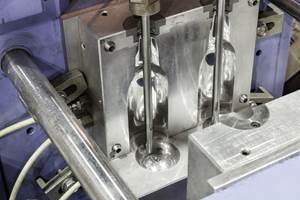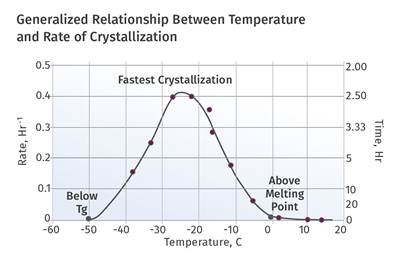A Processor’s Most Important Job, Part 1: Molecular Weight
Many processors don’t realize that preserving material characteristics is crucial to product success and failure. The focus here is on molecular weight.
This is part one of an eleven-part series focused on the most important job of a processor. To read the rest of this series, click these links:
part two, part three, part four, part five, part six, part seven, part eight, part nine, part ten, part eleven.
When I ask processors about their most important responsibility, the answers usually focus on factors relating to productivity. These typically include some conversation about cycle time, machine utilization, making parts to print, maintaining process capability indices (Cpk) of 1.33 or greater, etc. It is rare to hear any mention of molecular weight, crystallinity, preservation of additives, or minimizing molded-in stress. While these factors are the foundation for the success or failure of a product, processors often do not appreciate their own role in controlling them.
But if these characteristics are not given the proper attention, then all the aspects associated with productivity matter very little. The first material characteristic we will address here is molecular weight. It has been recognized for almost 100 years that the unique characteristics exhibited by polymers are due to the large size of the molecules and their extended-chain configuration.
Not a week goes by when I do not work on a failed product where polymer degradation is at least a factor.
This combination of characteristics gives rise to something called chain entanglement. It is the foundation of mechanical performance. Short-term properties such as impact resistance are particularly sensitive to changes in molecular weight. But long-term properties such as fatigue resistance and environmental stress-crack resistance are also closely correlated with the length of the chains that make up the material.
The manufacturers of plastics raw materials pay close attention to the molecular weight of the products they produce, and they capture this with a measurement of properties such as melt flow rate and intrinsic viscosity. It is then up to the processor converting the raw material to a molded article to preserve that molecular weight. This does not happen automatically. The elevated temperatures associated with melt processing, combined with the time that the material spends in the barrel, can have a significant effect on the molecular weight of the compound. The higher the melt temperature and the longer the barrel residence time, the greater the chances are that the molecular weight of the polymer will be negatively affected. The response in most materials is a process called chain scission, where the length of the chain is shortened by the thermal stress of processing.
In addition to the dual influences of time and temperature, the processing of some materials involves the potential hazard of degradation due to the presence of excess moisture in the material at the time of processing, a process known as hydrolysis. Condensation polymers such as polyesters, polycarbonate, nylon, and polyurethane are particularly susceptible to this problem. Drying these materials down to a moisture content that prevents hydrolysis is essential.
Get more insights on materials: Know How Materials
Proper control over melt temperature, residence time and—where appropriate—moisture content ensures that the molecular weight of the polymer will be properly maintained as the material undergoes conversion from pellets to parts.
While this sounds simple, not a week goes by when I do not work on a failed product where polymer degradation is at least a factor. Part of the problem is that product made of degraded material can often look just as good, can be made at the same cycle time and, when critical dimensions are measured, the parts are to print. Unless some type of mechanical performance test is performed by the processor, changes in molecular weight will go unnoticed until something fails after the product has moved farther down the supply chain. In a worst-case scenario, the part is in use by the final customer when it fails. Typically, the observed response is a brittle failure under stresses that are consistent with normal use.
In a proper failure analysis on anything made of a polymer, a molecular-weight determination should be performed, and ideally, this result should be compared with that of the raw material used to make the part. If this test reveals that the molecular weight has been reduced to an excessive degree, the process parameters should immediately become the focus of the investigation.
In some instances, it is necessary to demonstrate to the processor that orchestrated changes in the process variables mentioned above can turn the molecular-weight problem on and off. When these experiments are performed, the results are often surprising because they reveal an interaction between these process conditions.
Recently we performed such an exercise on a highly glass-fiber-reinforced nylon 66. A failed part returned from the field exhibited an excessive reduction in average molecular weight. A review of the product that had not yet been assembled showed that the problem was greater than just an errant start-up part; the molecular weight of the product varied widely from marginal to considerably worse than what had been returned from the field.
In response, we conducted a relatively simple experiment: We molded parts at two different melt temperatures, 525°F (274°C) and 575°F (302°C); both are within the limits of the suggested processing conditions. At each of these temperatures, we produced parts from material that was above the maximum recommended moisture content, material that was dried to just below that upper limit and material that was dried to a level considerably below the upper limit, what some in the industry might refer to as “overdried.”
In many instances, there is outright denial that the decisions made on the molding floor can influence the integrity of the polymer at a molecular level.
At the lower melt temperature, parts with good retention of average molecular weight were produced from all three moisture levels. Even the wet material yielded parts with no excessive reduction in molecular weight and there was no evidence of the cosmetic defects that are often associated with incompletely dried material. However, at the higher melt temperature, only the very dry material gave acceptable results. The material dried to a marginally “safe” level produced parts that exhibited a slightly higher-than-recommended change in molecular weight, while the wet material produced the type of change that had been observed in the field failure.
Once again, all parts had an acceptable appearance. Dimensional checks across all the experimental groups showed no statistically significant variations. Even some of the mechanical tests showed a negligible change in performance. However, when tests were performed that involved an impact loading, the problems with the parts molded from the degraded material became more evident.
Having been through an event such as this changes a processor’s focus—or at least it should. New attention is given to the process conditions and there is a heightened awareness that good parts cannot simply be defined by appearance and dimensional compliance. The condition of the material from which the parts are made is important, though it cannot always be verified with the techniques that are typically employed in a molding facility.
For processors who have never made the connection between their process conditions and the health of the polymer in the molded part, their role in that outcome remains a mystery. In many instances, there is an outright denial that the decisions made on the molding floor can influence the integrity of the polymer at a molecular level. This is despite the fact that we have known about the relationship between molecular weight and plastics performance for almost 100 years.
Molecular weight is just one of the material characteristics influenced by the process conditions. Next time we will look at another one: crystallinity.
About the Author
Michael Sepe
Michael Sepe is an independent, global materials and processing consultant whose company, Michael P. Sepe LLC, is based in Sedona, Arizona. He has more than 40 years of experience in the plastics industry and assists clients with material selection, designing for manufacturability, process optimization, troubleshooting and failure analysis. Contact: 928-203-0408 • mike@thematerialanalyst.com.
Related Content
Fundamentals of Polyethylene – Part 6: PE Performance
Don’t assume you know everything there is to know about PE because it’s been around so long. Here is yet another example of how the performance of PE is influenced by molecular weight and density.
Read MoreThe Importance of Melt & Mold Temperature
Molders should realize how significantly process conditions can influence the final properties of the part.
Read MoreThe Effects of Stress on Polymers
Previously we have discussed the effects of temperature and time on the long-term behavior of polymers. Now let's take a look at stress.
Read MoreThe Effects of Time on Polymers
Last month we briefly discussed the influence of temperature on the mechanical properties of polymers and reviewed some of the structural considerations that govern these effects.
Read MoreRead Next
A Processor’s Most Important Job, Part 2: Crystallinity
Process conditions help determine the difference between the maximum degree of crystallinity that can be achieved in a polymer and the degree that is present in a molded part.
Read MoreBeyond Prototypes: 8 Ways the Plastics Industry Is Using 3D Printing
Plastics processors are finding applications for 3D printing around the plant and across the supply chain. Here are 8 examples to look for at NPE2024.
Read MoreMaking the Circular Economy a Reality
Driven by brand owner demands and new worldwide legislation, the entire supply chain is working toward the shift to circularity, with some evidence the circular economy has already begun.
Read More
.jpg;width=70;height=70;mode=crop)





















